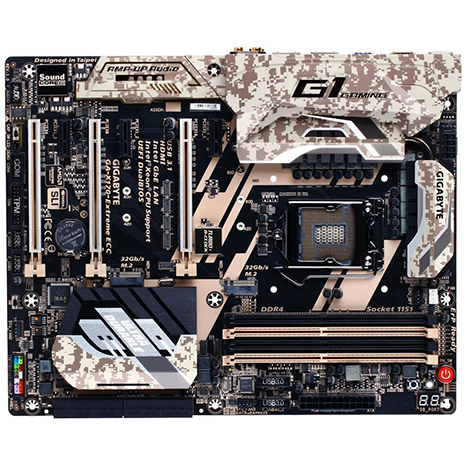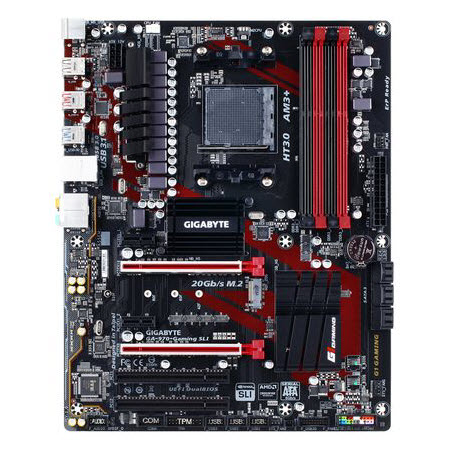ASRock Fatal1ty E3V5 Performance Gaming/OC Intel C232 Motherboard Review
Is there value in a budget gamer workstation? Are Intel's C232 chipset and Xeon part of the answer? We're putting ASRock's E3V5 Performance Gaming/OC motherboard on the test bench in an attempt to find out.
Why you can trust Tom's Hardware
Test Configuration, Results, And Final Analysis
The Tumbler PC makes its way back to the bench to receive this ASRock E3V5 Gaming/OC sample with only a few modifications. The Corsair AX860 continues to supply this system with power, with its 80 Plus Platinum certification delivering efficient power throughout a wide range of load scenarios. We rely on the DeepCool GAMMAXX 400 recommended by fellow Tom's Hardware members to cool the Xeon processor.
Test System Configuration
| RAM | Kingston KVR24N17S8/8 4x8GB DDR4-2400 CL17 UDIMM |
|---|---|
| Graphics | Gigabyte GeForce GTX 970 G1 Gaming 4GB |
| Sound | Integrated HD Audio |
| Network | Integrated Gigabit Networking |
Gigabyte donated a GTX 970 G1 Gaming GPU for use in today's tests. The main difference between this card and our previous Windforce sample (procured for the Gigabyte-X170 review because of time constraints) is a few MHz on the core and memory clocks and a fancy backplate. It will be interesting to see if the extra hertz provide any discernible performance differences.
Toshiba has sent the Tom's Hardware motherboard team samples of its 250GB OCZ RD400 NVMe M.2 offering. The package comes with both a PCIe break-out board and the actual drive. The lack of M.2 connectors on this motherboard board has forced us to deploy a PCIe M.2 riser card to properly compare ASRock's C232 motherboard to Gigabyte's C236.
When you talk about server or workstation PC guts, most of the time they are boring, green, and have no pizazz. For this review, Kingston supplied four sticks of its DDR4-2400MHz 8GB ValueRAM to replace the previous configuration's uninspiring green DIMMs. With the ECC vs non-ECC performance debate settled, we opted to only include the UDIMM results from Kingston here.
Comparison Motherboards
Synthetics and Applications

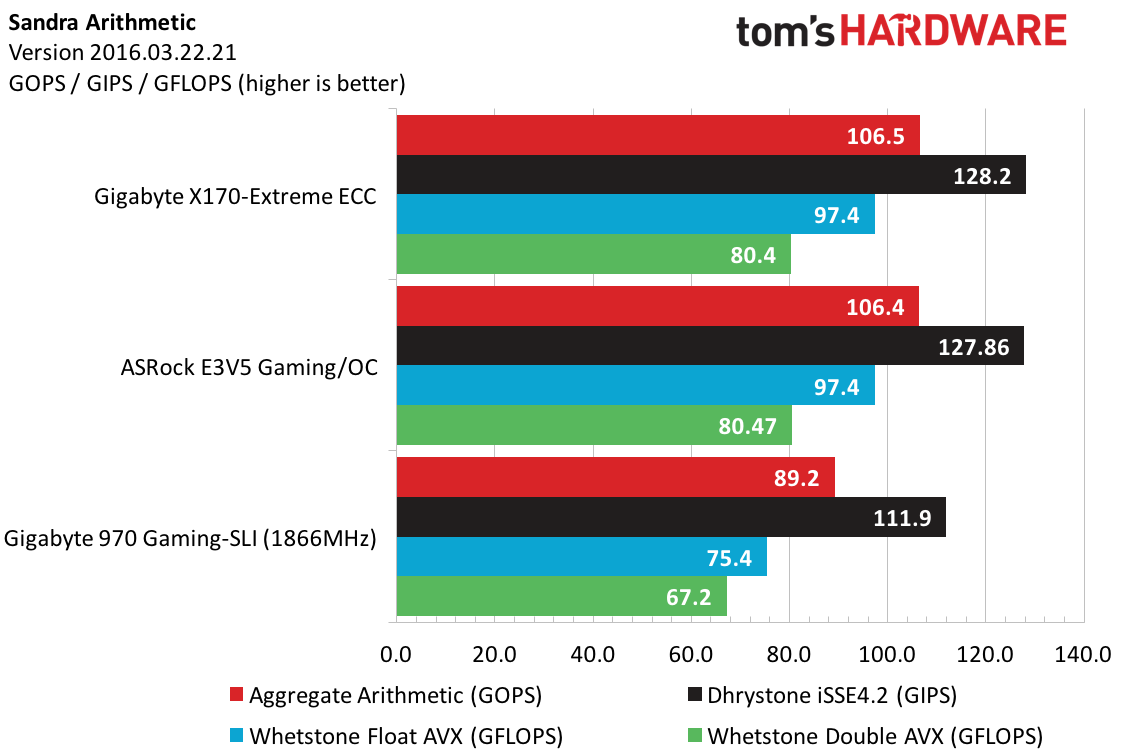
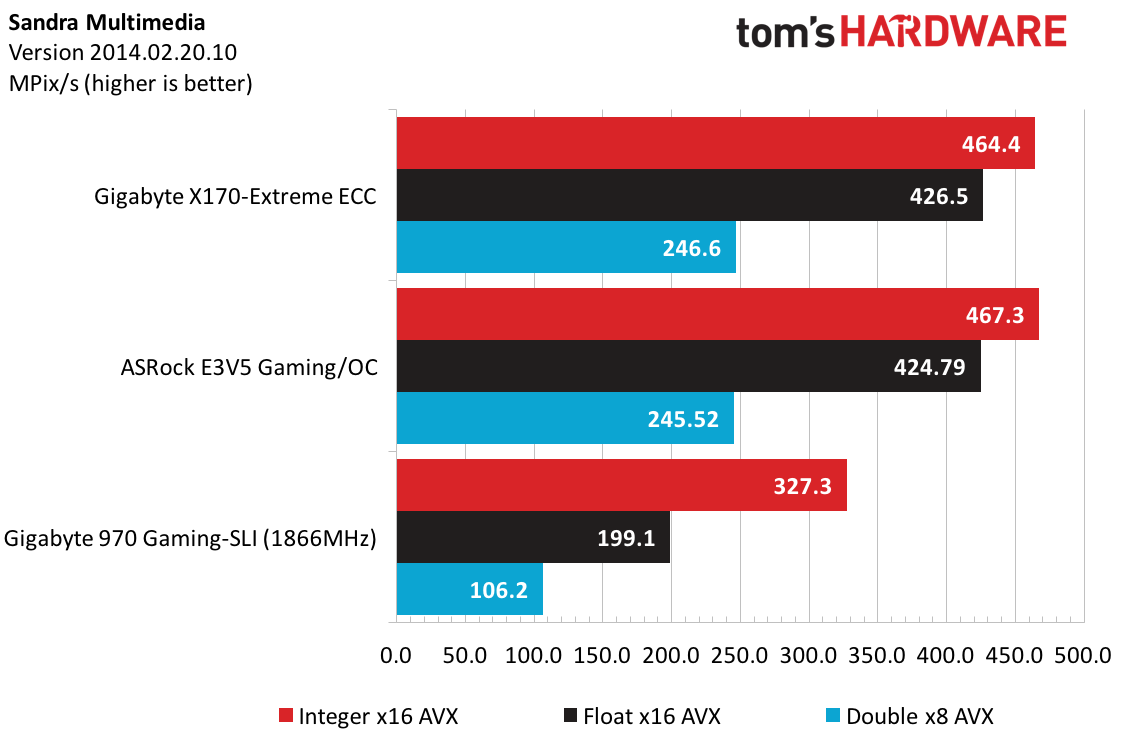

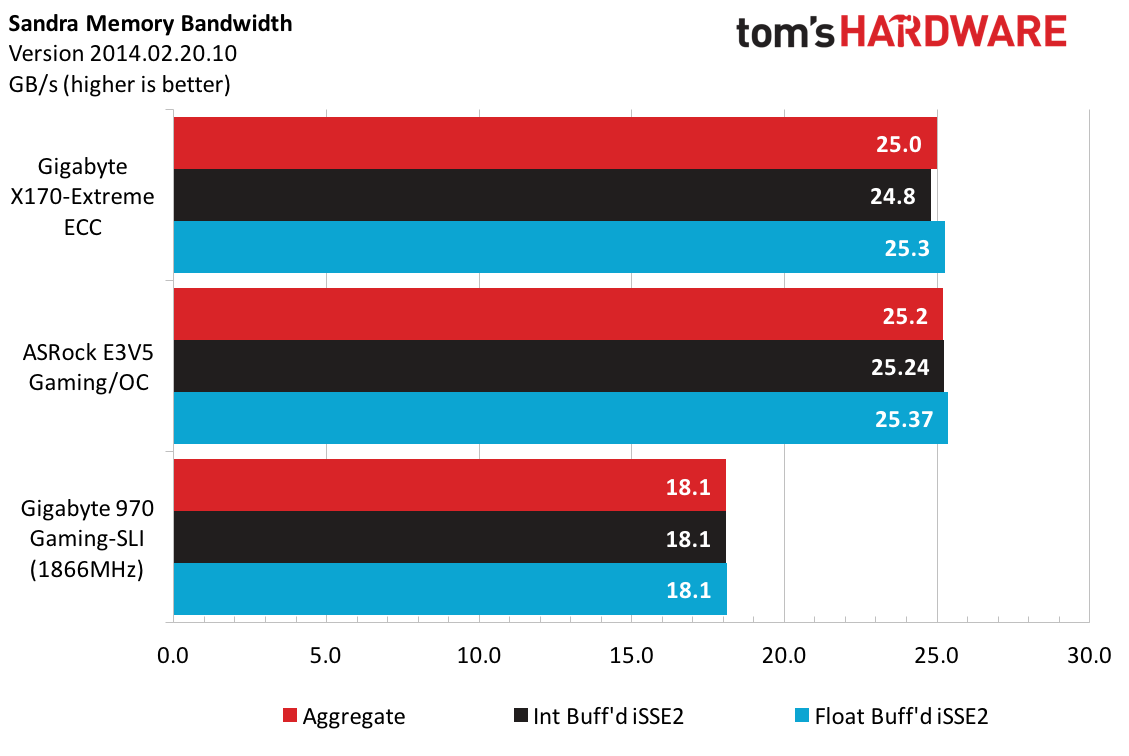
There are two different ways to look at the data this time around. We're comparing the ASRock E3V5 Gaming/OC board to the previous C236 platform (Gigabyte-X170) and to our last AMD article results (Gigabyte 970 Gaming-SLI), of course, using the same Windows 10 image. From a synthetic perspective, both platform analyses are clear. The (C232) E3V5 Performance Gaming/OC comes within points of the (C236) X170-Extreme ECC, and the only PCMark application where it doesn’t smoke the AMD system is the storage test. Sandra continues the overall trend, and the only significant change is the memory bandwidth test, where the ASRock inches out a 0.2 GB/s lead compared to the C236 platform.
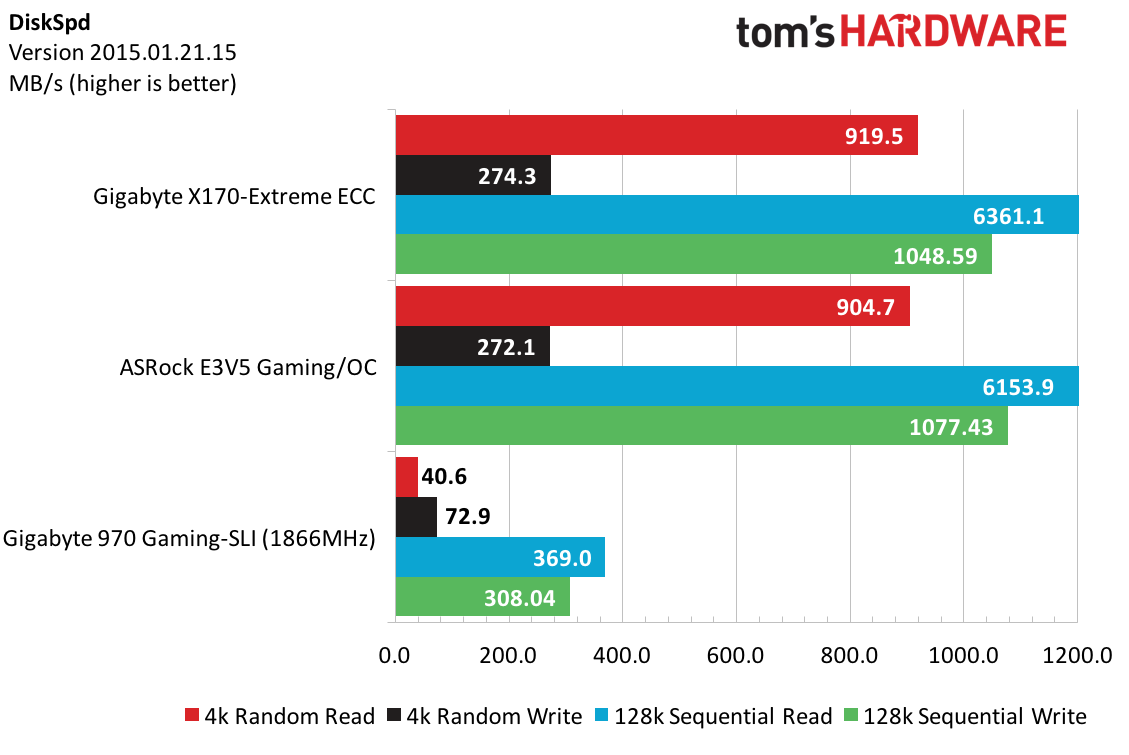
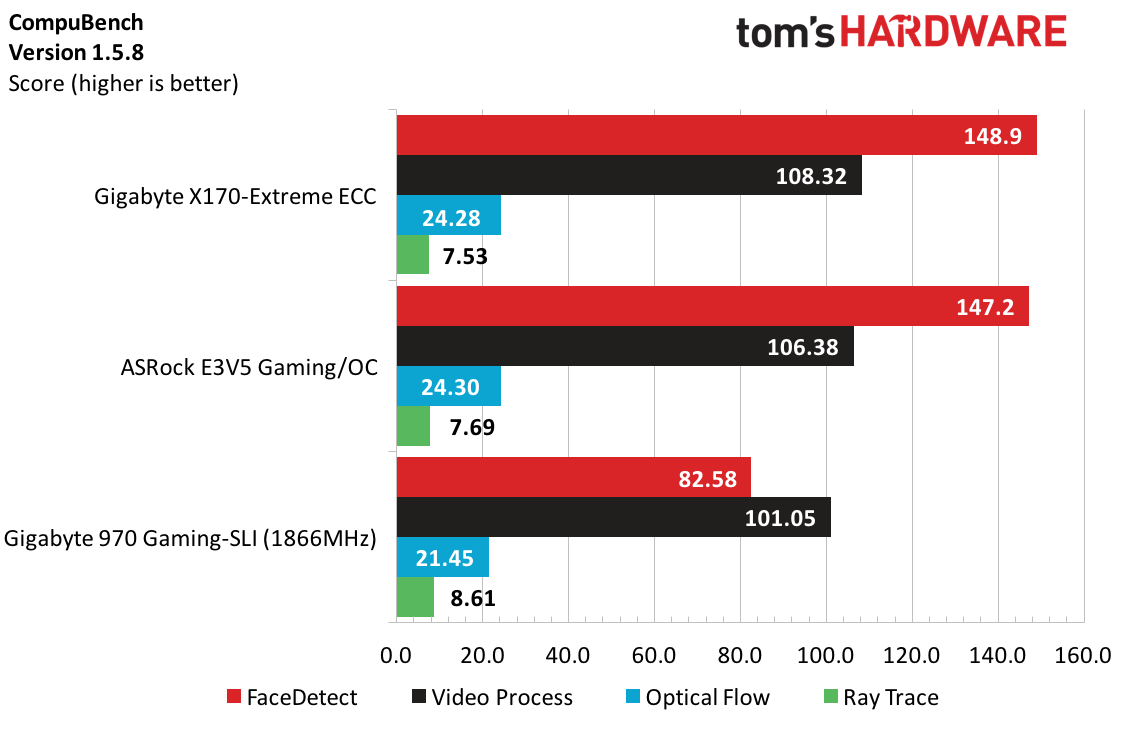
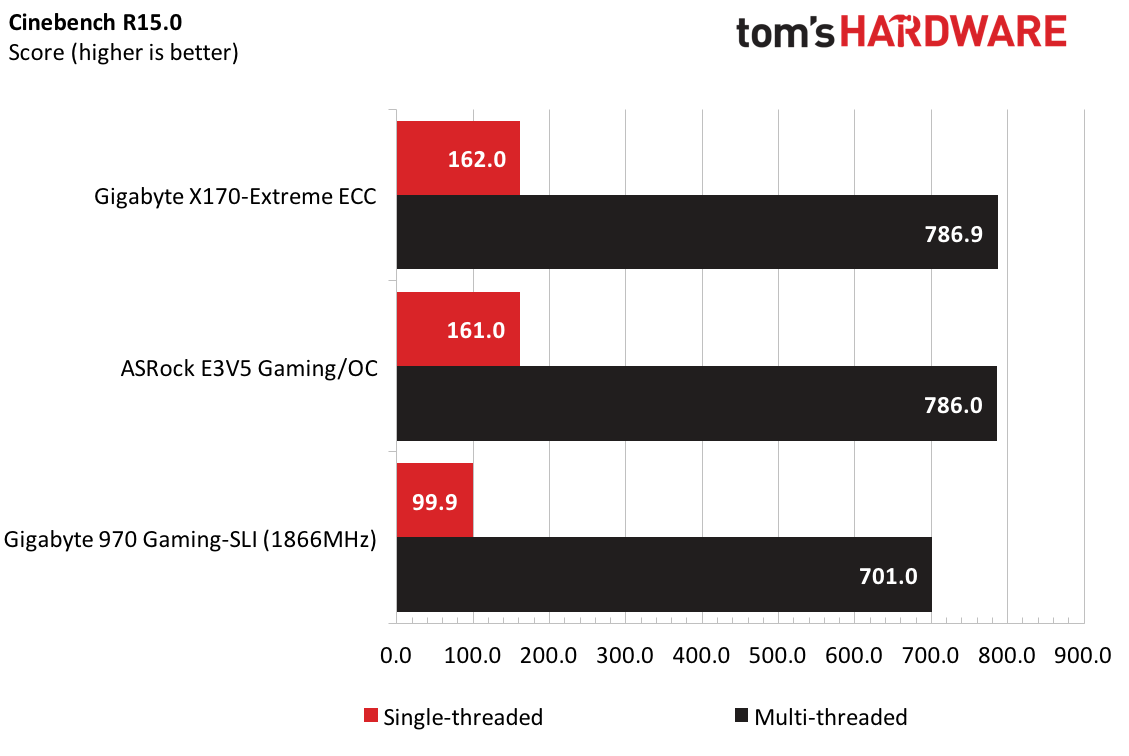

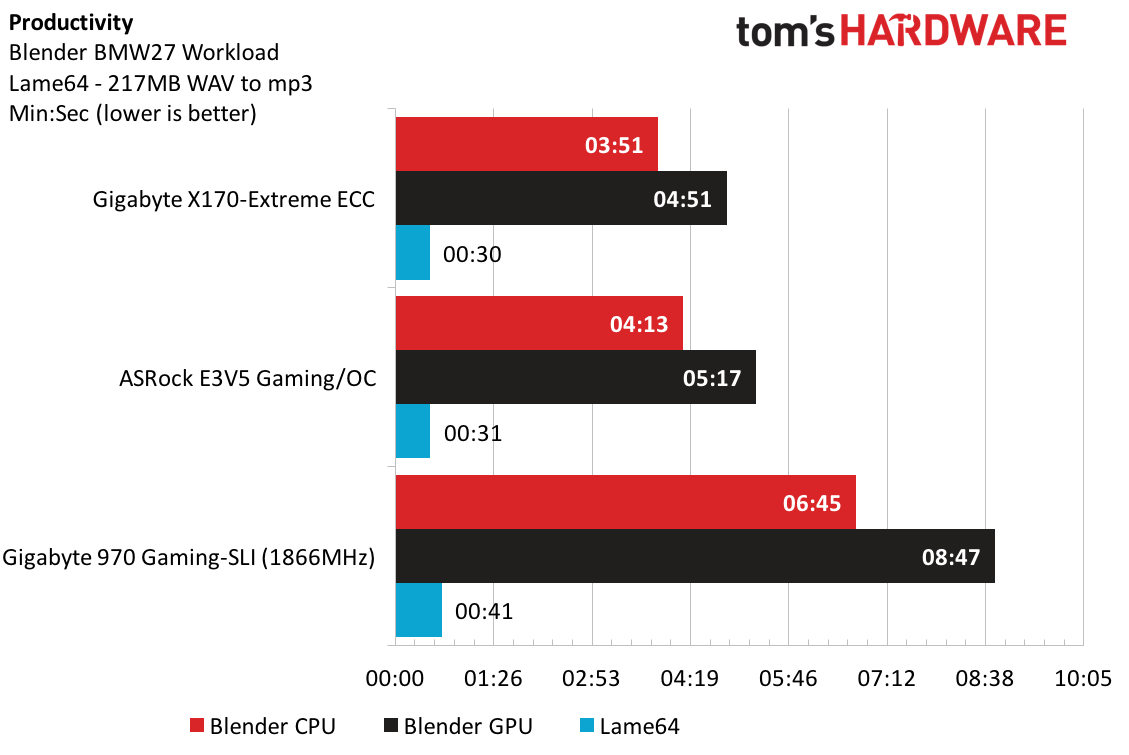
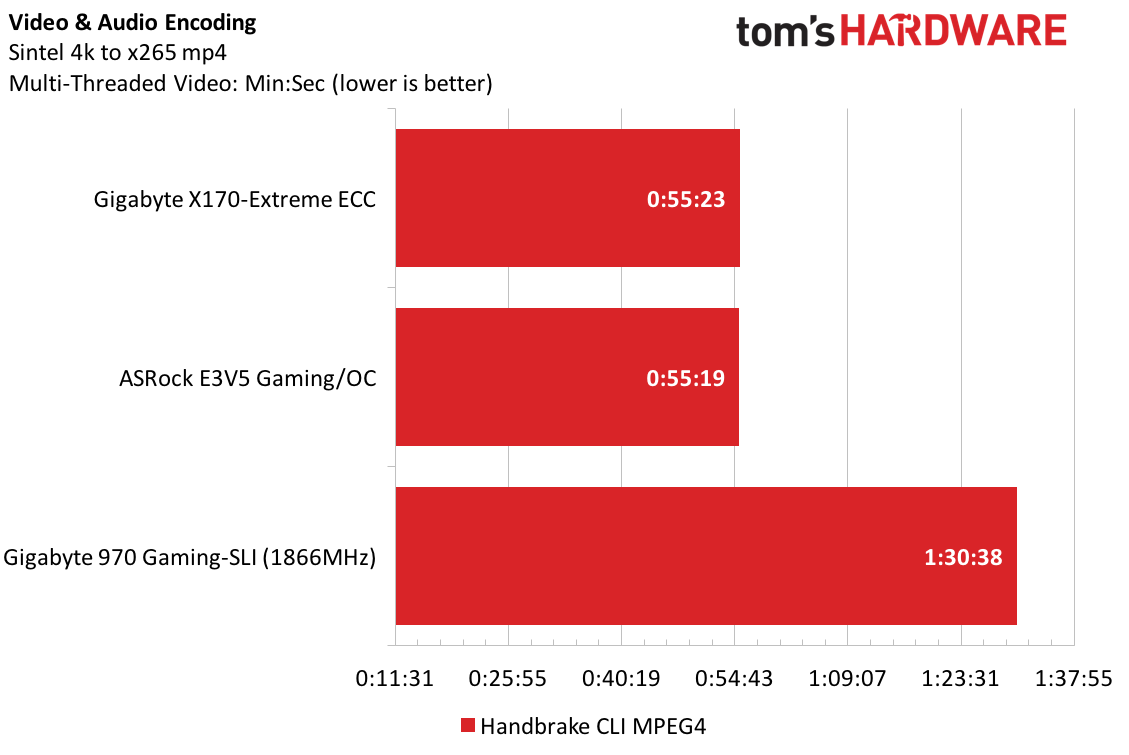
There are mixed results with DiskSpd, where sequential reads were down 200 MB/s but writes were up by 50 MB/s. This could be due to the change in interface with the PCIe riser card, but the 3% difference is well within the margin of error for such a high-speed connection. Given the nature of the application tests, these results nearly put us to sleep. Handbrake clearly prefers the Intel platforms, and file compression is again so close that the scale of the chart is misleading. However, Blender shows a 20 second increase in render time on the ASRock E3V5 Gaming/OC motherboard compared to the Gigabyte X170 Extreme-ECC. Are there any other programs that we should run against this hardware? Let us know in the comments!
Games

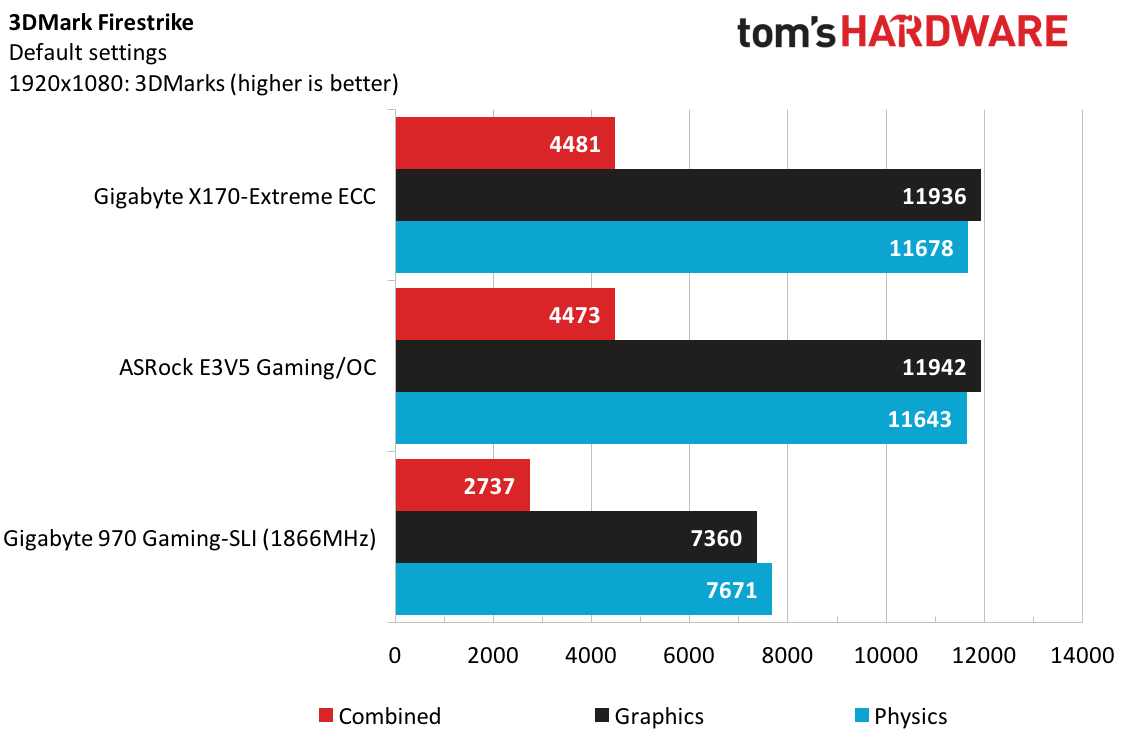
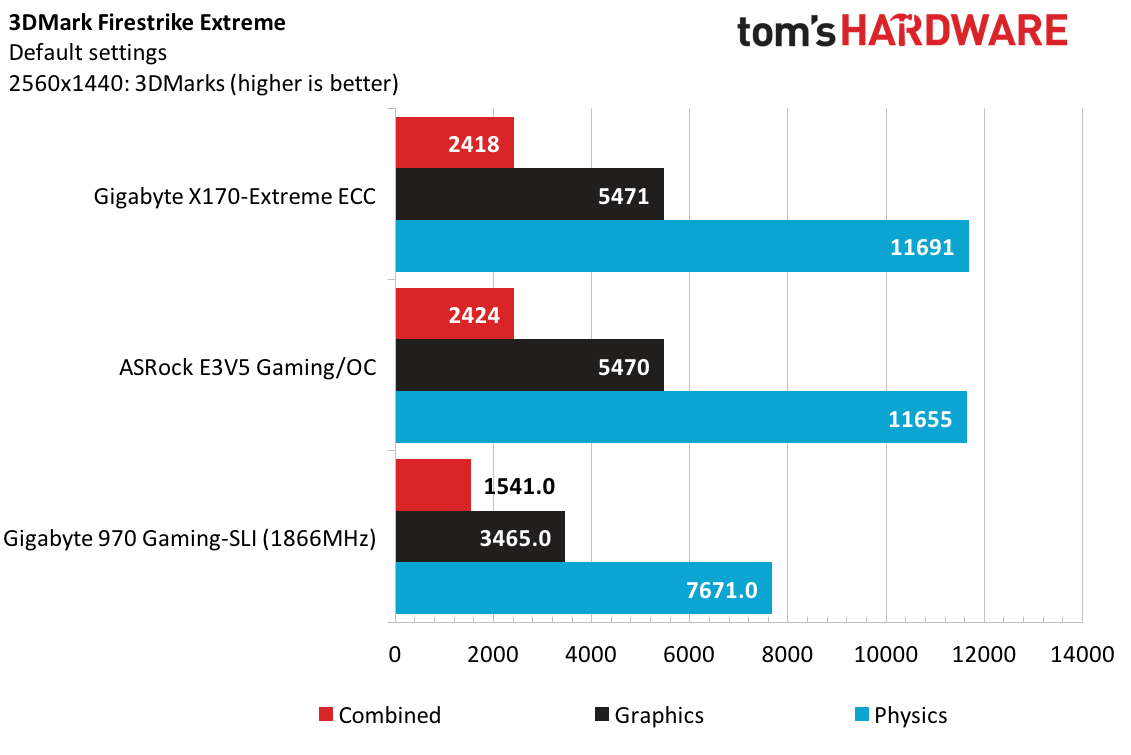
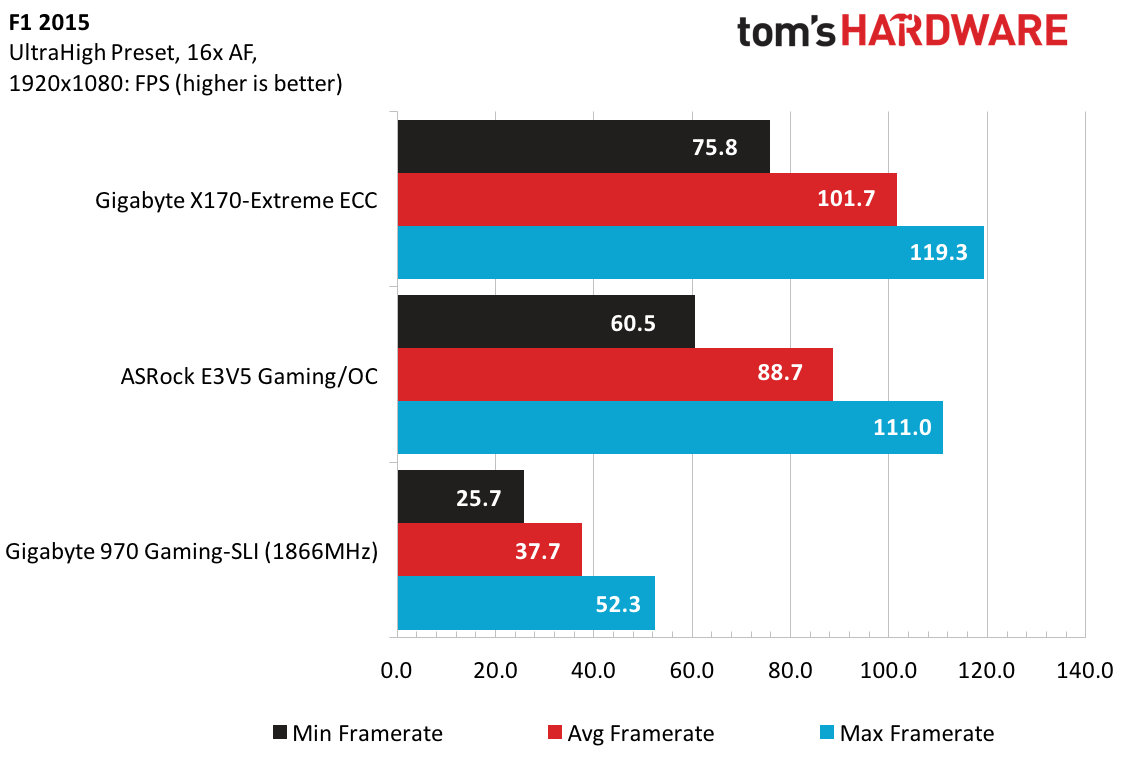
The inclusion of the G1 Gaming in place of the standard Windforce 970 will account for much of the differences between the Xeon-based systems. Judging by the 3DMark synthetics, both graphics solutions behave as expected and stomp the AMD 7970 card’s performance. The F1 2015 results have us perplexed, given the synthetic results for both the CPU/memory and 3DMark scores. If you’ve seen similar results in this application, let us know in the comments. Regardless, this GPU is overkill for this resolution and monitor.
Get Tom's Hardware's best news and in-depth reviews, straight to your inbox.


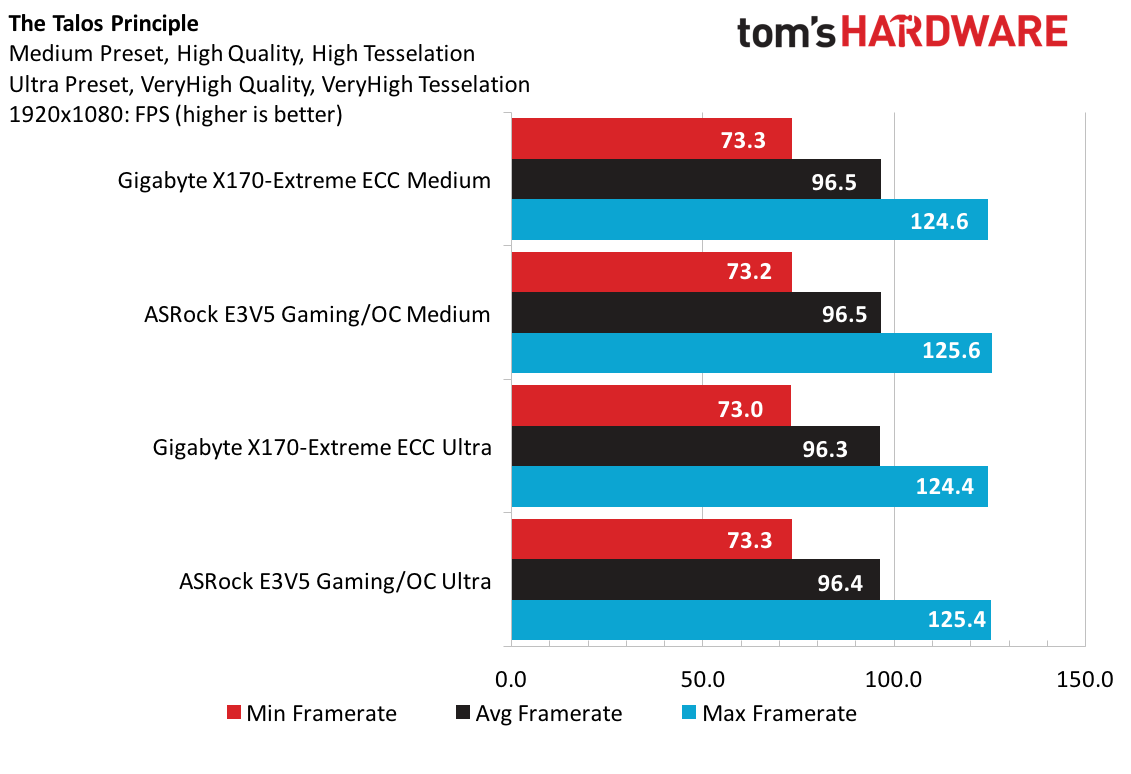

Continuing with Ashes, when using High settings both chipsets are within a few frames of each other, but cranking up the settings to Crazy clearly suits the G1 Gaming solution’s additional core and memory frequencies. Metro gives a slight edge to the ASRock E3V5 Gaming/OC configuration by a few frames across all tested settings. The Talos Principle is still uninspiring as always, showing very consistent results across settings, though the G1 Gaming does gain a frame here and there.
Power And Efficiency
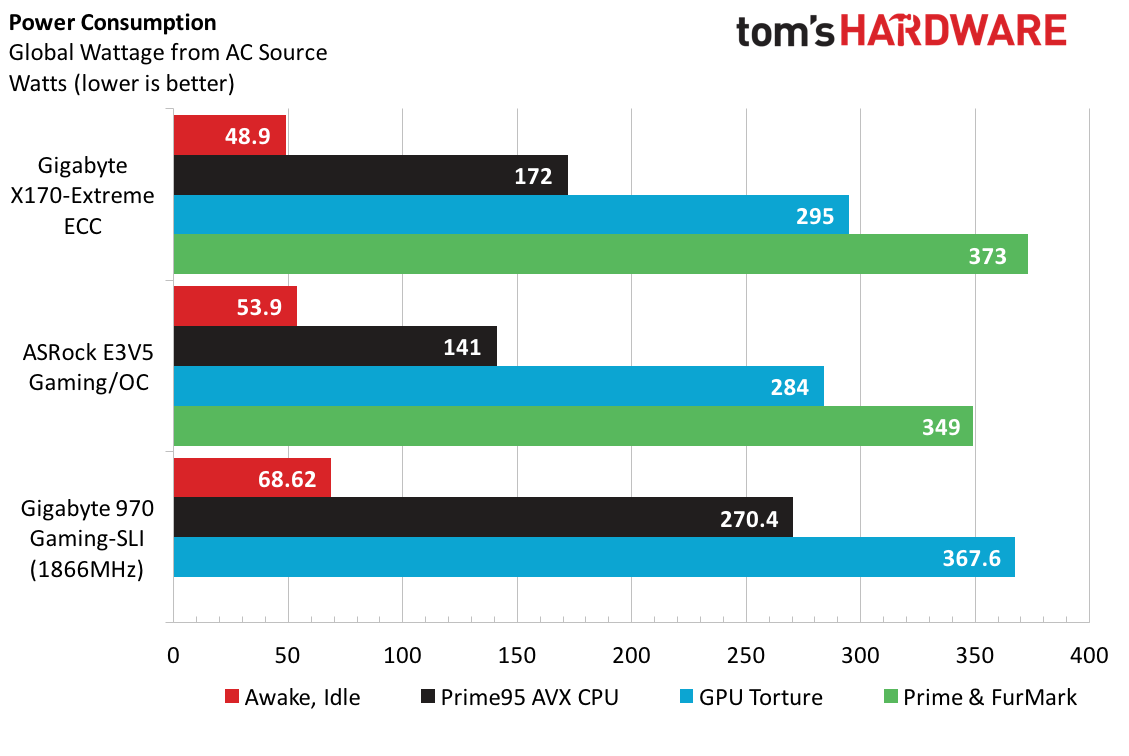
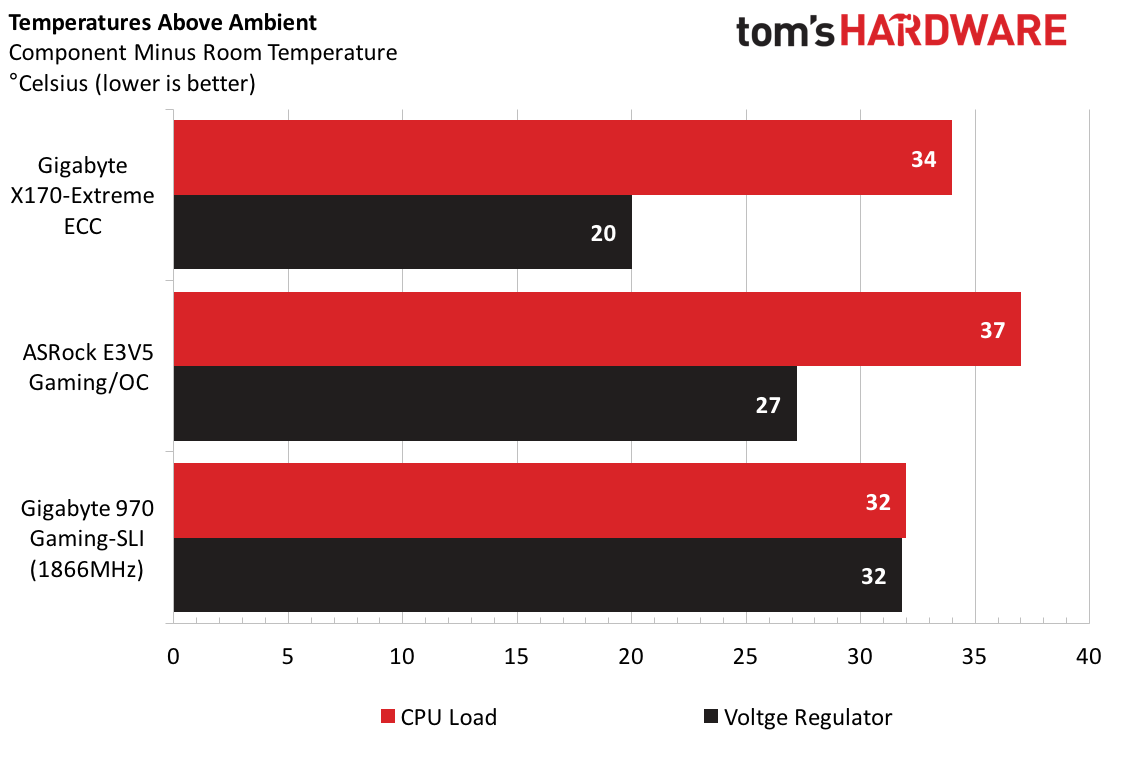

With our trusty Kill-A-Watt in place, we can start observing true differences between the C236 and C232. Though the ASRock E3V5 platform draws five more watts from the wall at idle, the power distribution of this C232 sample is 30W more efficient at full CPU load and 11W more efficient at full system utilization. Temperatures are higher despite the win in power draw for the ASRock E3V5. The 7° difference on the voltage regulators are clearly the result of the design of ASRock’s heatsink. The Gigabyte X170 has a behemoth of a solution compared to the ASRock E3V5, and surface area is important. Even with sizably smaller heatsinks, these components can effectively provide stable power to these voltage rails at modest temperatures.
From an efficiency perspective, AMD is clearly struggling and if the leaked Zen charts give me any hope, I have something to look forward to in the next few months. Back to Xeon, given the better power draw and the almost-up-to-snuff performance, efficiency goes to the ASRock E3V5 Gaming/OC sample.
Overclocking, Performance, and Value
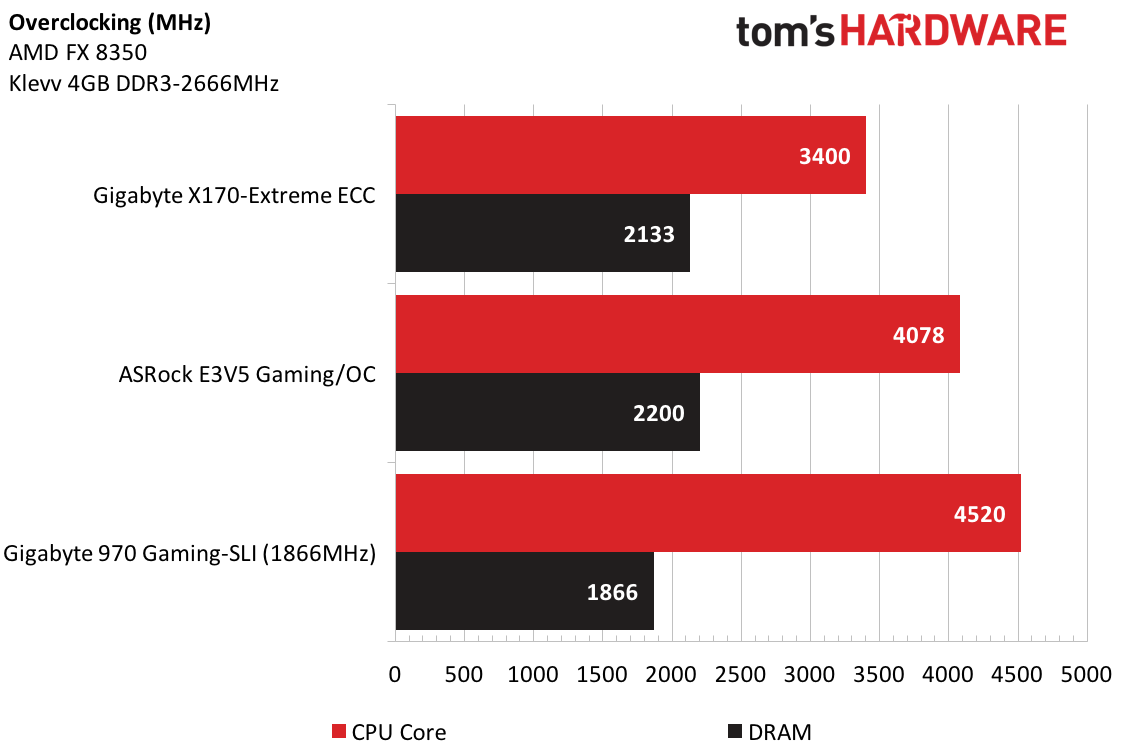

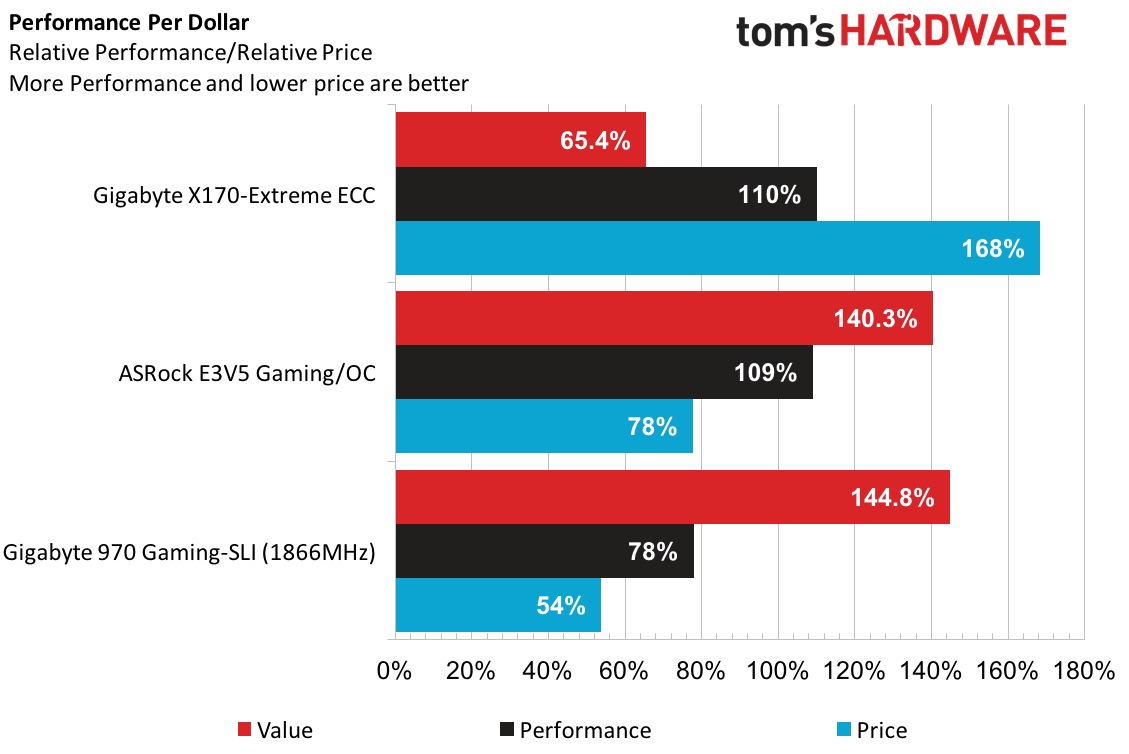
Having already spilled the beans with performance, the ASRock E3V5 Gaming/OC performs nearly identically in Apps and Games. Let's not forget to mention that AMD is dragging by nearly 30%.
The wildcard for the E3V5 is overclocking. Despite Intel mandating that multipliers be locked and that chipsets not enabling overclocking, manufacturers have opted to enable overclocking by adjusting the BCLK frequency fed into the CPU. Though increasing BCLK does directly impact frequency applied by stock multiplier settings to the CPU, BCLK also gets fed into memory operating frequencies and other processor and chipset reference clocks.
Over the course of overclocking this Xeon E3-1230, we wrestled with the memory settings of this configuration and nearly threw in the towel. With each adjustment of BCLK, we had to dance around the DDR4-2133 mandated specification of the platform and eventually settled on 2200 MHz at CL17 speeds. With BCLK set to 120 MHz (up 20% from spec) and adding 50 mV to the processor, we successfully set a stable 4078 MHz clock with all power saving options disabled through the UEFI. Though nowhere near what Thomas achieved, we feel like we proved that this board can apply the juice and options to those willing to risk their CPUs and wallets.
Conclusion
Back to the original question: is there value in a budget gaming workstation? Judging by performance alone, the C232 can deliver near identical levels of performance to the C236 in the configuration tested. If we planned on deploying any kind of high performance attachments, such as a SAS RAID card, high performance gigabit Ethernet network, or an SLI graphics configuration, C232 is not the droid you're looking for. Ditching the NVMe riser card, we could gain four additional PCIe lanes, but compared to the wealth of options available to C236, we may just stick with what we have in deployed in this C232.
What about consumer grade options? Yes, you can get most of the same bells and whistles on Z170, if not H170, but if your livelihood relies on uptime and reliability, spend the extra cash on ECC and buy at least a motherboard with the C232 chipset.
As far as C232 is concerned, this ASRock E3V5 Performance Gaming/OC delivers a similar experience to other more expensive solutions while providing more stability and features, such as larger VRM heatsinks and that Fatal1ty flair. Outside of complaints about C232, we can’t find anything wrong with this product. However, unless ECC is necessary, we wouldn't blame anyone for using a standard consumer board instead.
MORE: Best Motherboards
MORE: How To Choose A Motherboard
MORE: All Motherboard Content
- 1
- 2
Current page: Test Configuration, Results, And Final Analysis
Prev Page Introducing The E3V5 Performance Gaming/OC-
Mark_304 Not sure why they used Fatal1ty as branding, since its a workstation.. but does look good.Reply -
genz If you don't understand why they used Fatal1ty as a branding you didn't read the article, Mark. It clearly states it's because it's for gaming with workstation processors and supports overclocking. EVGA made the SR-X a long time ago and many similar units have popped up since.Reply
It's for the gamers that want to run a 64 core render farm off the same machine they develop and game on. Indie devs and power users that would actually be served if the top of the consumer CPU markets weren't comparatively stagnant to times gone by. -
firefoxx04 If intel would stop restricting the instruction sets available on i7s we wouldnt have to mix and match workstation with gaming.Reply
You dont need a gaming board to develop. Hell, you dont need a gaming board to play games. The idea that motherboards are tailored to "GAMING" because they have flashy colors and lights is just silly. -
BulkZerker Flashy colors, heatsinks on hot running components, better sound solutions, more connectivity, more expensive network solutions... Yea gaming boards sound like absolute shite yo.Reply -
anbello262 Reply19324209 said:Flashy colors, heatsinks on hot running components, better sound solutions, more connectivity, more expensive network solutions... Yea gaming boards sound like absolute shite yo.
To be honest, the more expensive network solutions are almost no difference, if any. More connectivity is debatable, since that is actually part of Z170 itself (not gaming), there is usually very little "gaming boards" exclusively have to offer on that front. Depends a lot more on the mobo form factor (ATX vs mATX)
The Heatskinks are quite good for extreme overlclokers with extreme voltages, but that has no real value in gaming.
For gaming, we already know that CPU performance is secondary (it's more than enough with any 4.5GHz new i7, or even i5 most of the times). Even a locked i7-7700 would be enough probably. Getting your chip higher (5.0GHz 7770k?) depends mainly on the chip itself and then on the MOBO stability, but even then, it would require extreme voltages and constant stress testing to worry about overheating MOBO parts (always talking about Intel, not mentioning AMD).
The only part I will agree is the good sound solution. But it's all about economics, and in that fron it actually makes sense to charge extra for more expensive mobos. I'm just saying that they offer virtually no benefits for gamers specifically (apart from the sound). -
genz Reply19323737 said:If intel would stop restricting the instruction sets available on i7s we wouldnt have to mix and match workstation with gaming.
You dont need a gaming board to develop. Hell, you dont need a gaming board to play games. The idea that motherboards are tailored to "GAMING" because they have flashy colors and lights is just silly.
Overclocking support for Xeon processors says otherwise. Not many boards in existance support that, and these kind of boards are excellent investments because in 4 years when the server market is done with their 10-core chips, I'll pick em up and OC them till they tear up 9900ks. -
junkeymonkey I see like the rest with the 100 series and up IDE mode has been removed for the sata configurations how does that benefit a w/s being that chipset used ?? you would full compatibility it offers ???Reply
I guess when all you IDE set up sata drives don't work you go buy new drives or loos all your data / wipe set to ahci reinstall everything ??
we were just discussing that here
http://www.tomshardware.com/answers/id-3340683/asrock-h170-pro4-hyper-ahci-ide-hdd-problem.html
this hardware today it now you got to go support it cause it no longer supports you then add windows 10 on top of that

